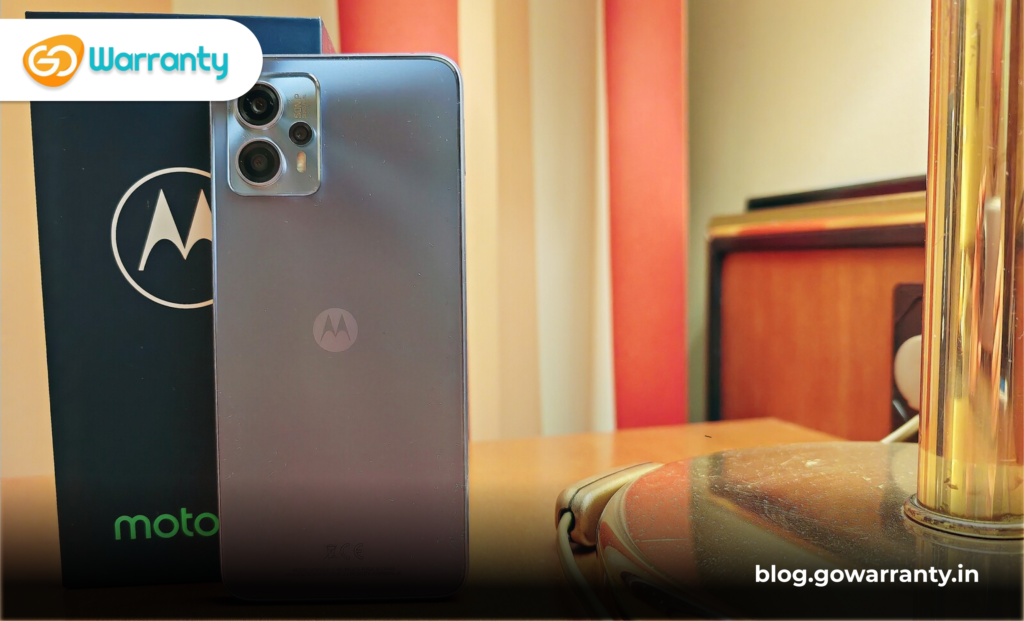Motorola’s ‘G’ series is aimed at anyone looking to buy a smartphone between Rs 10,000 and Rs 15,000. However, its most recent offering, the Moto G13, was released to broaden its portfolio in the low-budget market. It comes with a 6.5-inch HD+ IPS LCD panel, a 5,000mAh battery, a Mediatek Helio G85 SoC, MyUX based on Android 13, and much more for Rs 9,499 in India. Motorola’s Moto G13 makes competition difficult for the competitor, but how does it perform in real-world use? Learn more in our review.
Specifications Table
| Chipset | MediaTek Helio G85 |
| No of cores | 8 (octa core) |
| RAM | 4 GB |
| RAM Type | LPDDR4X |
| Height-Width | 6.41in-2.94in |
| Weight | 170 grams |
| Colours | Matte Charcoal, Lavender Blue |
| Resolution | 720 x 1600 pixels |
| Display Type | IPS LCD, Panda King Glass |
| Colour Reproduction | 16M Colours |
| TouchScreen | Yes, Capacitive, Multi-Touch |
| Rear camera setup | Triple |
| Rear Camera | 50MP(Primary), 2MP(Secondary), 2MP(Tertiary) |
| Front camera | 8 MP Resolution |
| Flash | LED Rear flash |
| Video Resolution | 1920×1080 @ 30 fps |
| Camera Features | Auto FlashAuto FocusFace detectionTouch to focus |
| Battery Type and capacity | Li-polymer, 5000 mAh |
| Fast Charging | No |
| Internal memory type | 64 GB |
| Operating System | Android v13 |
| Custom UI | No |
| SIM Configuration | Dual SIM |
| Wi-Fi | Yes |
| Bluetooth | Bluetooth v4.2 |
| GPS | Yes with A-GPS, Glonass |
| Fingerprint sensor | Yes, Side |
| Face Unlock | Yes |
| Other Sensor | Light SensorProximity SensorAccelerometerCompassGyroscope |
Design
The Moto G13 initially reminded us of the Redmi Note 12 Pro series. It has the same camera module and design as the Redmi Note 12 Pro. When rotated, the camera module looks like a shocked robot face. This appears to be a common design for low-cost electronics these days. The sole variation between the two phones’ components is the orientation of the LEDs, which stand vertically on the Moto but lie horizontally on the Redmi.

The device is boxy in shape with curving edges. It has the same matte plain plastic design as the other Moto G-series phones. The camera island, on the other hand, now has a glossy effect. It has a slick back, which requires the use of a case. Fortunately, one is included in the box. It only attracts fingerprints when you hold it tightly or press hard on the back. We were given the Lavender Blue hue option, which is just stunning. When light strikes on it, it provides a ray-like effect. We liked it, but if you like something more subtle, you can always try the Matte Charcoal model.
Display
The Moto G13 comes with a 6.5-inch IPS LCD display. Of course, because it’s an entry-level gadget, you can’t complain about the lack of an AMOLED panel, but if you want one, there’s always the Moto G32, whose price has recently dropped. The display has an HD+ resolution, which is surprising at this price point given that Full HD+ panels have become common in this sector. As a result, you’re constantly looking for greater sharpness and clarity.
Despite the fact that it is an LCD, the G13’s display provides brilliant colours. By default, it is set to the Saturated profile, which you may alter to Natural if you like a warmer tone, which we don’t.
On the front, Motorola has chosen a PANDA protective glass, which is common for entry-level handsets. The panel refreshes at 90Hz and offers a touch sampling rate of up to 576 Hz, which is higher than what other phones in this category provide. The Moto G13 features tiny bezels around the display as well as a larger one on the chin. Furthermore, a large punch-hole for the front camera takes up a lot of room.
Software and Performance
The Moto G13 is powered by a Mediatek Helio G85 chipset, which is the most common entry-level SoC this year. It has 4GB of RAM and up to 128GB of storage, which can be expanded to a terabyte using a microSD card. There’s no virtual RAM nonsense here, which we think is for the best. We’re happy with the 4GB model, but offering a 6GB model at a slightly higher price range would have made a lot more sense.
During our testing, the Moto G13 worked wonderfully. While navigating across the UI, we didn’t notice any stuttering, although it does struggle to load apps like Instagram and Twitter. We tried split-screen multitasking to push it to its limits. While the combination of YouTube and Google Photos worked amazingly well, when utilising YouTube with Chrome, the processor began to lose steam.
The Moto G13 runs the MyUX operating system, which is based on Android 13. However, it will only receive one major software upgrade, which is disappointing given that two years is standard at this price. Rest assured, it will receive three years of security patch updates. Motorola has a reputation in the cheap segment for giving a clean software experience. However, even Moto couldn’t avoid bloatware in order to earn a profit at such a cheap pricing point, which is understandable.
Camera
The Moto G13 comes equipped with a 50-megapixel triple back camera as well as 2-megapixel macro and depth sensors. We would have liked an 8-megapixel ultrawide sensor over these two auxiliary cameras, but at this pricing, the options are limited. It has an 8-megapixel front-facing camera for selfies and video calls.
The camera app has a Google Camera-style interface and a variety of modes such as Portrait, Panorama, 50MP, Dual capture, Slow motion, Pro, Time-lapse, and Night vision. Here are the outcomes. For a phone this cheap, the main sensor on the Moto G13 shoots outstanding photos. The photos are detailed and have a wide dynamic range. The colours are well-produced, and the shadows are well-balanced.
Battery and Charging
The Moto G13 has a 5000mAh battery, which is approximately what every other phone offers these days. Given the low-resolution display, it’s no wonder that the battery lasts around a day and a half. We used the device extensively, spending nearly an hour reading Instagram and three hours watching YouTube videos, and it still offered us a total screen time of eight and a half hours.
The Moto G13’s charging performance may be better. It supports 10W charging and takes nearly three hours to charge from 0% to 100%. The Lava Blaze 2, which is less expensive than the Moto G13, supports 18W charging. Charging takes place through a Type-C connection, which is a nice thing.
Verdict
The Moto G13 is undeniably one of the best cheap smartphones on the market right now. The pattern is nothing exceptional, but the Lavender Blue trim adds a nice touch. It boasts a strong main camera, and despite its underpowered processing, it has been designed for a seamless experience on a budget. Of course, this is not for hardcore gamers, but it is adequate for casual gaming.
Despite having a nearly stock Android UI, the G13 has some drawbacks, including bloatware and recommendations, a lack of a full HD+ display, and a weak edge detection mode. However, these features should be a lot for anyone purchasing a phone for less than Rs 10,000.

